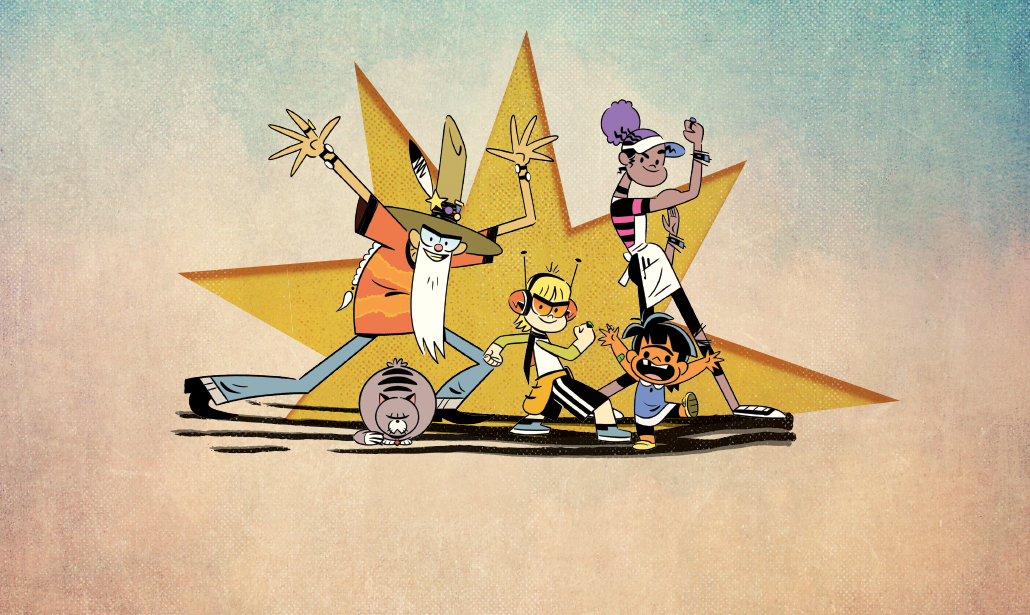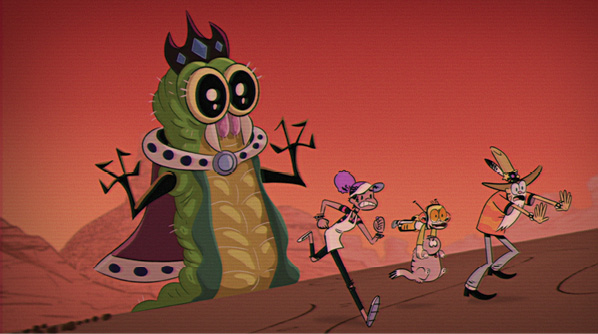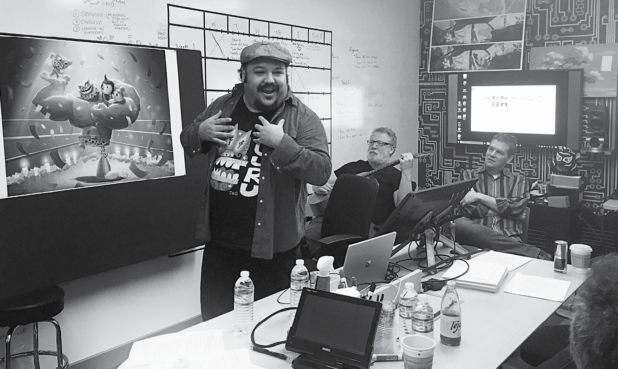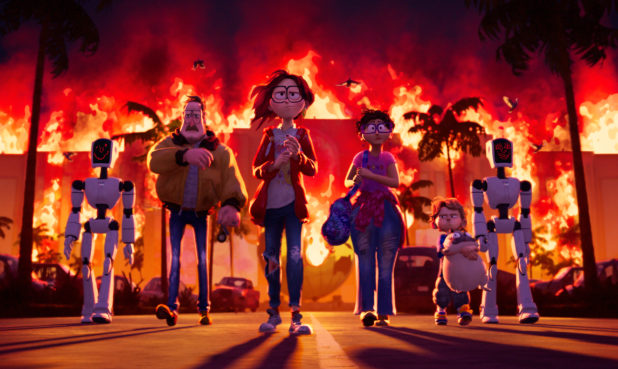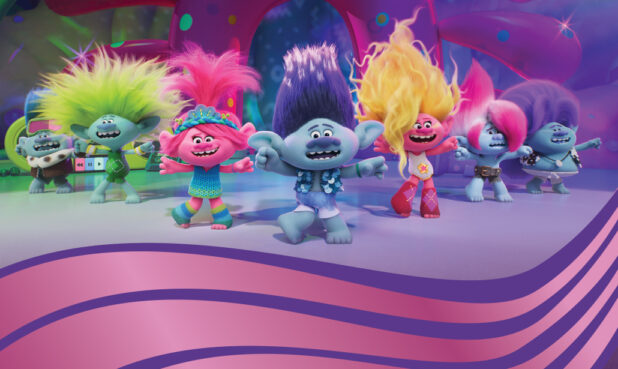If you’ve ever road-tripped through the American West, you’ll instantly recognize Mo’s Oasis Café. It’s one of those off-the-beaten-path joints, set back from the highway, surrounded by a faded landscape and frequented by a Wes Anderson-meets-Buckaroo Banzai cast of regulars. Seeing it on your TV screen, you’ll feel certain you’ve been there before—a nostalgic sense of familiarity that gives Kid Cosmic its appeal.
With the full season premiering globally on Netflix on February 2, Kid Cosmic is the latest 2D TV show from Craig McCracken, following a string of successes including The Powerpuff Girls, Foster’s Home for Imaginary Friends, and Wander Over Yonder. The latter ended in 2016, and in the years following, McCracken developed a new show that is his most personal yet.
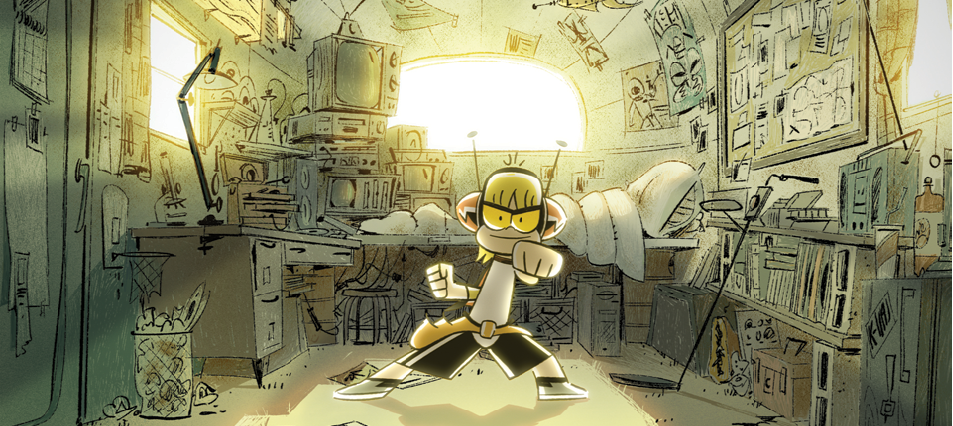
While the concept began its fermentation process in McCracken’s imagination in 2009—an odd kid in love with superheroes, living in the desert and hanging out at a truck stop—its influences date back to his childhood. They are rooted in reality (the death of his father when he was seven) and escapism (his love of comics). “When I was growing up,” he says, “I was a big fan of Tintin. It was cartoony, but it felt like he was going on these real-world adventures. He was surrounded by broad, eccentric characters, but you could still see them as human beings.”
The problem in pitching his “odd kid” story back then was that McCracken could not envision Kid Cosmic as a typical cartoon with standalone episodes. It needed to be serialized, and networks weren’t interested in doing that, he says, so he shelved it. Jump forward a few years. McCracken saw shows like Gravity Falls and Steven Universe, and realized the time might be right for his idea. He shared it with his friend Francisco Angones, who had worked as a writer and story editor on Wander Over Yonder, and his wife, fellow animator Lauren Faust.
The freedom that resulted can be seen in everything from the characters and the artwork to the soundtrack and the serialized storyline. McCracken explains, “[We’re] telling a story about a character going through something, and turning out to be different at the end than they were at the beginning. That’s something I’ve never been able to do in any of my shows, and it’s been really exciting to be able to explore that.”
The story follows Kid, a 9-year-old boy who lives with his grandpa in a junkyard out in the desert. He has long fantasized about being a superhero, and in the wreckage of a spaceship crash, he finds five stones that bestow superpowers on those who possess them. As aliens from around the galaxy invade earth to get these ancient cosmic artifacts, Kid is thrilled to have special powers so he can save the planet and all mankind. But his wide-eyed ideas about being a superhero smash headlong into the shatterproof wall of reality.
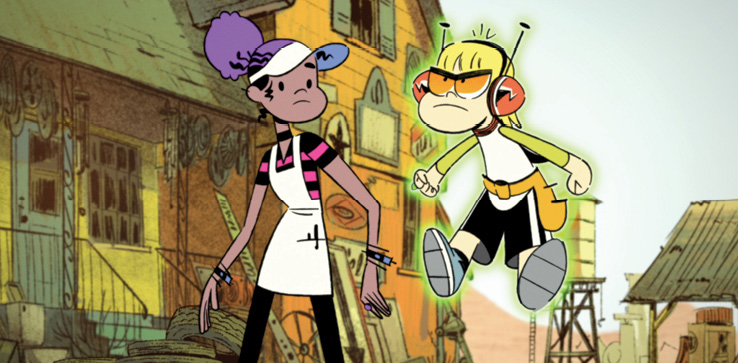
“There’s this certain age when you’re a kid when you have these really lofty ideas,” McCracken says. “You think you can pull [them] off, but when you get into reality, it doesn’t manifest that way. I think that’s what separates Kid Cosmic from other kid hero shows. The humanness of it. Kid’s allowed to be himself. … He can make mistakes.”
-
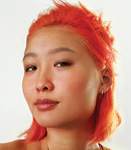
“For most of my life, I was—and still am—heavily inspired by comics. The linework in many comics, especially French, is beautifully detailed and supplemented by simple color. When I was told the style of the show is very much inspired by French comic work, it was a pleasant surprise!” – Mabel Ye -

“Craig’s desire for a hand-drawn look is something I’ve always been partial to. I had gained a reputation over the years as being one of the last people in the business that draws in pencil on paper. In fact, Kid Cosmic is the show where I finally made the transition to work completely digitally. I knew that because the line would be in the final painted backgrounds, it would be necessary to have all the layout artists using the same digital brushes rather than have everyone work traditionally.” – Chris Tsirgiotis -

“We treated Kid Cosmic like we were making a film, as opposed to a cartoon with a capital C. I always joke that it is an animated series. …We did a lot of live action as far as storyboarding styles, to make it feel more grounded and real.” – Craig McCracken
“Cats were my best friends growing up,” McCracken says. “Of course, we’re going to put a cat on the team, because that’s what a kid would do, and what use is a cat going to be?”
Due to circumstances beyond his control, Kid isn’t the only one who winds up with a cosmic stone. There’s teenage Jo, based on McCracken’s older sister who introduced him to The Beatles and Monty Python; Rosa, a strong-willed 4-year-old with a maniacal laugh and oddly excellent comic timing; Papa G, channeling Willie Nelson’s laid-back outlaw attitude while caring for Kid in his parents’ absence; and Tuna Sandwich, a cat.
To Tuna Sandwich’s credit, he’s very useful—in his own way. That seems to be the point of each character, how their less than hero-worthy qualities become assets as they discover their individual superpowers. Not only are they quirky in personality, they’re unique from one another in the way they look. For this, McCracken worked closely with the show’s Character Design Supervisor, Steve Lambe.
The threesome created a script and animatic. They pitched it to Netflix, and soon they were working on ten 22-minute episodes. According to Rob Renzetti, who has worked on all of McCracken’s shows and serves as Co-Executive Producer on Kid Cosmic, “There’s not one aspect of the show that has needed to be altered or compromised because of a ‘note from the network.’ Their notes are almost always on target and are never mandatory.”
“In past shows I’ve worked on,” Lambe says, “it was about throwing as many fancy design elements into a character as possible, to make them look interesting. One of the great things I’ve found working with Craig, is that he believes in finding that one special theme to a character, and then building the rest of the design around their story. Kid desperately wants to be a superhero. We could have made his costume look amazing, like something out of a Marvel movie. Instead it’s a mishmash of all the leftover items found in the junkyard he lives in. And none of it fits quite right. His costume is an extension of his personality.”
The characters, which are crafted in classic cartoon style, provide a visual contrast to the settings. The show’s Lead Background Designer, Chris Tsirgiotis, explains, “Craig wanted … a very believable place filled with the little details that one would typically see.” Tsirgiotis also worked on Wander Over Yonder, and says that McCracken has always given him great creative freedom, “So keeping the setting in mind, I decided to go with a more realistic treatment rather than a very stylized or flat graphic look.”
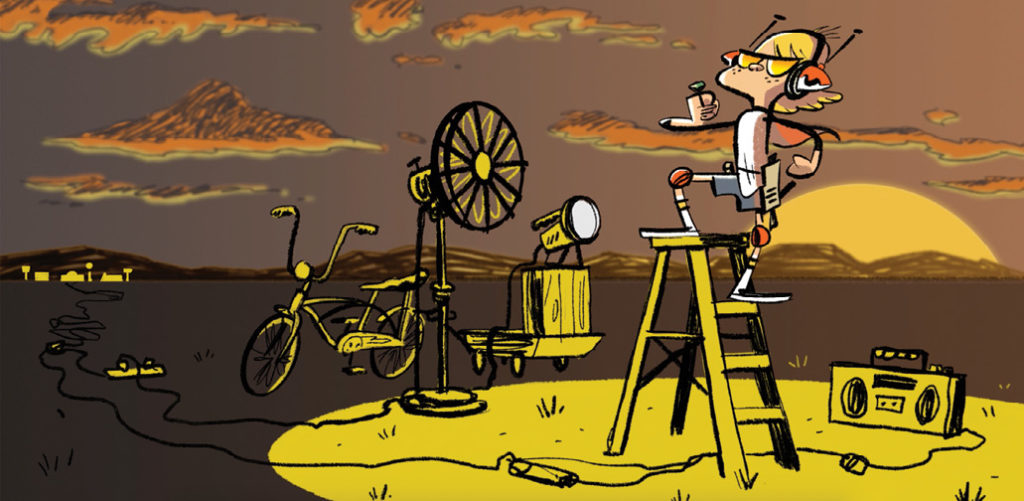
According to Background Designer Maryam Sefati, most shows she’s worked on flatten parts of the design to push this cartoony look Tsirgiotis describes, and it was a fun challenge to figure out how to use realistic camera angles. One method that was especially helpful, she says, was the use of 3D models for spaceships, cars, and some of the main locations like Mo’s Oasis Café. Not only did these models help speed up the work, they resulted in details that were more accurate from different perspectives.
In addition, the Kid Cosmic team looked at a lot of classic illustrators to explore techniques to convey the feel they wanted. Lambe credits Golden Age legends such as Charles Schulz and Hank Ketcham for the “simplicity, fluidity, and economy of their lines,” while Tsirgiotis was influenced by the “sketchy and loose but well-drawn inking style” of European comic books.
McCracken credits Background Painter Mabel Ye for the unique painting style that helped achieve this look. “When color is used subtly,” she says, “it helps linework and texture really sing. Chris’ linework is gorgeous, and I hoped to highlight that with a more understated painting style. I enjoy treating digital mediums with traditional techniques. In this case, instead of relying too heavily on texture layers or overlays, texture is created by individual ‘scratches’ during the painting process. Similarly, instead of using opacity, colors are blended by controlling the density of scratchy brushstrokes.”
“Because so much of the inspiration for the show’s style comes from comic books,” Tsirgiotis adds, “we decided early on that the line would go hand in hand with the color on the backgrounds. That’s another reason for the looser, quickly drawn line quality. I also wanted to give the backgrounds a little bit of a gritty feel that would help evoke the dusty and worn quality of locations set in the desert of the American Southwest.”
The result of all these various approaches created just the effect McCracken wanted: “Rough around the edges. …All of that is to remind you, these are drawings made by humans. We wanted to keep that homemade, handmade, kind of punk rock aesthetic. Kid and his team are essentially punk rock superheroes. Meaning, they may not have the skill or the talent, but they have the determination and conviction to do this. They have that punk rock sensibility.”
It’s not surprising McCracken mentions music when he talks about Kid Cosmic, because the soundtrack plays a crucial role. “When I’m developing any show,” he says, “one of the first things I do is find a playlist or music that inspires the world I want to create, and I use that as inspiration. In 2015, when Frank, Lauren, and I were developing the show, I reached out to Andy Bean, who was our composer on Wander. I said, I need you to pretend to be a garage punk band from the early ‘70s called Dr. Fang and the Gang.” Not only did McCracken use these raucous songs as inspiration, they play a major role in the show, including the theme song.
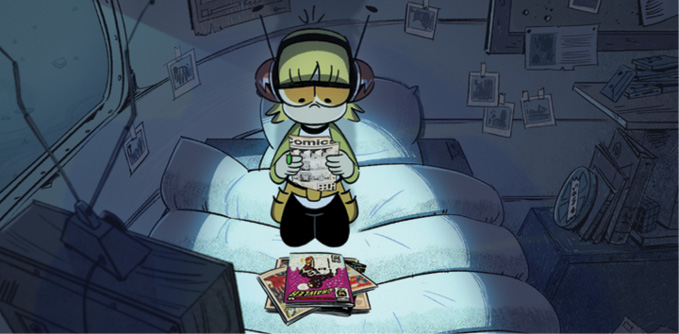
Kid Cosmic has a lot of sophisticated silliness—think the cantina scene in the original Star Wars. It also lets itself be serious, something McCracken realized he could do because of childhood movies like E.T. where “kids experience heavy stuff. I wanted to lean into that sort of thing. Yeah, Kid doesn’t have his parents. …He doesn’t have a lot of resources. There’s not any real other kids around. But he makes the best of that situation, and that’s who he is as a character. Well, I’m gonna try to do the best I can in this situation I’m in. That’s his real power.”
